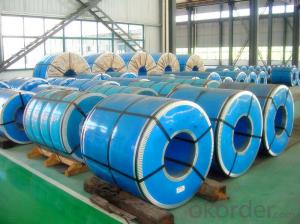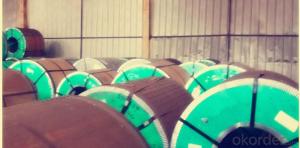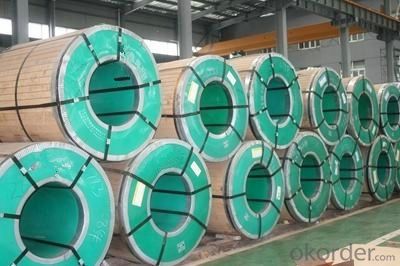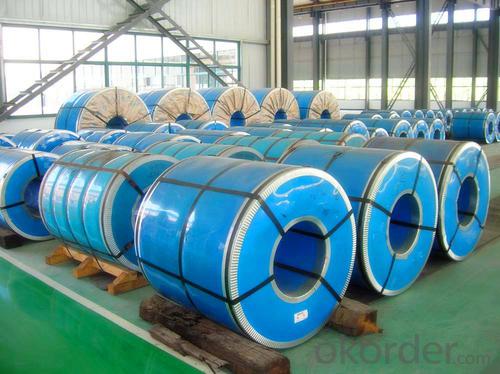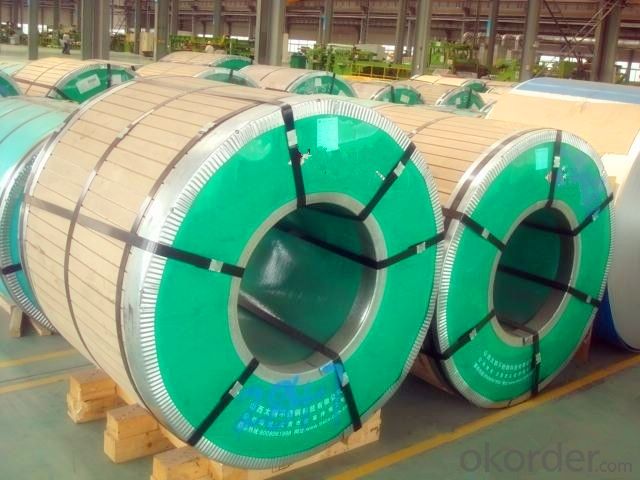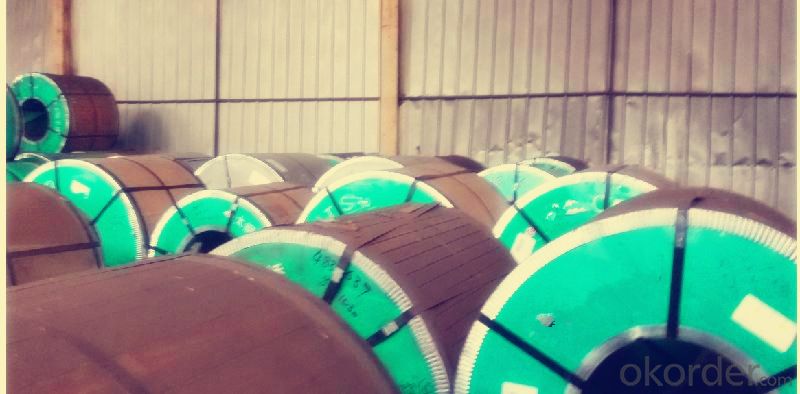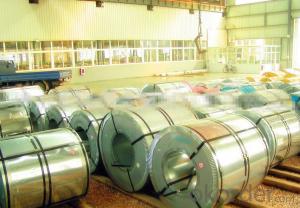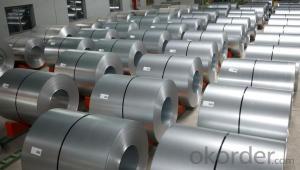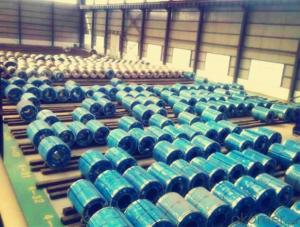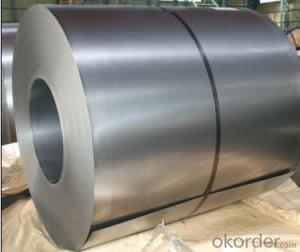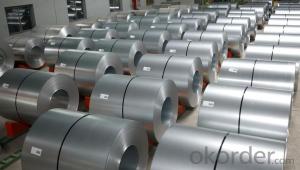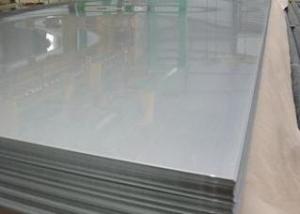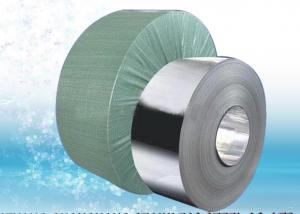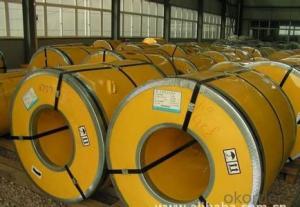Stainless Steel Coil 304 Hot/Cold Rolled 2B/BA/NO.1
- Loading Port:
- Guangzhou
- Payment Terms:
- TT OR LC
- Min Order Qty:
- 100 m.t.
- Supply Capability:
- 20000 m.t./month
OKorder Service Pledge
OKorder Financial Service
You Might Also Like
Hot Rolled Stainless Steel Coil 304
Annealing and Pickling No.1 Finish
Stainless steel is a production which not easy rust,acid resistance and corrosion resistance,so it is widely
used in light industry,heavy industry,daily necessities and the decoration industry.
Hot Rolled Stainless Steel Coil 304 Specifications
1.surface:NO.1
2.standard:JIS, AISI, GB
3.width: 0.55m, 0.65m, 1.0m, 1.22m, 1.5m, 2m or requirement
Hot Rolled Stainless Steel Coil 304 Chemical Composition:
(%):C=0.07, Mn=2.00, P=0.045, S=0.030, Si=0.075, Cr=17.5-19.5, Ni=8.0-10.5, N=0.10
Hot Rolled Stainless Steel Coil 304 Physical Properties
Tensile strength σb (MPa) ≥ 520
the conditions yield strength σ0.2 (MPa) ≥ 205,
elongation δ5 (%) ≥ 40
Reduction of ψ (%) ≥ 50,
hardness: ≤ 187
HB; ≤ 90
HRB; ≤ 200H
- Q: Can stainless steel strips be used in solar energy systems?
- Yes, stainless steel strips can be used in solar energy systems. Stainless steel is a durable and corrosion-resistant material, making it suitable for outdoor applications. It can be used in solar panels, mounting frames, and other components of solar energy systems to provide structural support and longevity.
- Q: What are the different types of surface defects in stainless steel strips?
- Stainless steel strips can have various types of surface defects, which can affect their appearance, performance, and overall quality. Some common types of surface defects in stainless steel strips include: 1. Scratches: These are visible lines or grooves on the surface of the strip, which may be caused during manufacturing, handling, or transportation. Scratches can vary in depth and severity, with deeper scratches potentially affecting the corrosion resistance of the stainless steel. 2. Pits: Pitting is the formation of small, localized cavities or depressions on the surface of the strip. Pits can be caused by various factors, such as exposure to corrosive environments, improper cleaning, or manufacturing defects. Pitting can compromise the integrity of the stainless steel and make it more susceptible to corrosion. 3. Stains: Stainless steel strips can develop stains or discoloration due to exposure to chemicals, heat, or improper cleaning methods. Stains can range from light discoloration to more severe, deep stains that are difficult to remove. These defects can impact the appearance of the stainless steel and may also indicate a compromised protective oxide layer. 4. Roll marks: Roll marks are impressions or ridges on the surface of the stainless steel strip that are caused during the rolling process. These marks can be visible as lines or patterns and are often a result of uneven pressure or improper alignment of the rolling equipment. Roll marks can affect the aesthetics of the stainless steel and may also impact its mechanical properties. 5. Weld defects: Stainless steel strips that are produced through welding processes can have various weld defects, including weld spatter, incomplete fusion, or excessive penetration. These defects can weaken the joint and reduce the overall strength and corrosion resistance of the stainless steel strip. 6. Surface contaminants: Stainless steel strips can also have surface defects in the form of contaminants, such as dirt, oil, grease, or foreign particles. These contaminants can be introduced during manufacturing, handling, or storage, and can negatively impact the performance and appearance of the stainless steel. It is important to note that the severity and impact of these surface defects can vary depending on the intended application of the stainless steel strip. Manufacturers employ various quality control measures to minimize these defects and ensure that the stainless steel strips meet the required standards.
- Q: Can stainless steel strips be used in the production of watches?
- Yes, stainless steel strips can indeed be used in the production of watches. Stainless steel is a popular material choice for watch cases, bands, and other components due to its durability, corrosion resistance, and aesthetic appeal. The strips can be precisely cut and shaped to create various watch parts, including cases, bezels, bracelets, and clasps. Stainless steel strips provide a sleek and polished look to watches and are highly versatile, making them suitable for both traditional and modern watch designs. Additionally, stainless steel is known for its strength and longevity, ensuring that watches made with stainless steel strips will be durable and withstand daily wear and tear.
- Q: What are the common uses of stainless steel strips in the chemical filtration industry?
- Stainless steel strips are commonly used in the chemical filtration industry for various purposes such as structural support in filter systems, as filtration media for removing impurities from liquids or gases, as components in filter elements, and as screens or sieves for separating particles of different sizes. Their corrosion resistance, durability, and high temperature resistance make them ideal for handling corrosive chemicals and maintaining the efficiency of filtration processes in the industry.
- Q: How do stainless steel strips perform in abrasive environments?
- Stainless steel strips are renowned for their exceptional performance in abrasive environments, thanks to their unique composition featuring a significant chromium content. This composition grants stainless steel strips excellent resistance against corrosion, oxidation, and wear, making them highly durable and capable of enduring the harsh conditions typically found in abrasive environments. The presence of chromium in stainless steel strips creates a protective layer known as a passive film on the surface. This film acts as a barrier against corrosive elements and possesses the remarkable ability to self-repair. If the passive film becomes damaged, it will swiftly regenerate, further enhancing the strip's resistance to abrasion. Additionally, the mechanical properties of stainless steel strips contribute significantly to their success in abrasive environments. With high tensile strength and toughness, these strips can withstand the impact and forces exerted by abrasive particles. As a result, stainless steel strips are ideal for applications that involve constant contact with abrasive materials, such as in the mining, construction, or manufacturing industries. Moreover, stainless steel strips are available in a variety of grades, each tailored to meet specific requirements. For instance, duplex stainless steels exhibit superior resistance to pitting and crevice corrosion, making them particularly well-suited for extremely corrosive abrasive environments, such as those found in marine or chemical processing industries. In summary, stainless steel strips excel in abrasive environments due to their corrosion resistance, self-repairing passive film, and high mechanical strength. Their ability to withstand wear and tear makes them a dependable choice for applications where constant exposure to abrasive substances is anticipated.
- Q: Can 111 stainless steel strips be formed into wire for various applications?
- Yes, 111 stainless steel strips can be formed into wire for various applications. Stainless steel strips can undergo a process called wire drawing, where they are pulled through a series of dies to reduce their diameter and form them into wire. This wire can then be used for a wide range of applications such as electrical wiring, springs, cables, and more.
- Q: What are the common uses of stainless steel strips in the textile industry?
- Stainless steel strips are widely used in the textile industry for various purposes due to their exceptional properties and characteristics. One common use of stainless steel strips in this industry is as reinforcement in textile belts and conveyor systems. These strips help to enhance the strength and durability of the belts, allowing them to withstand heavy loads and continuous operation without any deformation. Another common use of stainless steel strips is in the production of textile machinery components. These strips are used to manufacture various parts such as guide rails, needle plates, and cutting blades. Stainless steel's corrosion resistance and high temperature resistance make it ideal for these applications, ensuring a long lifespan and reliable performance of the machinery. Stainless steel strips are also utilized in the production of textile molds and dies. These molds are used for processes like fabric embossing or printing, where stainless steel strips provide excellent heat transfer and stability. The high tensile strength of stainless steel ensures that the molds can withstand the pressure and stress exerted during the manufacturing process. Moreover, stainless steel strips find application in textile weaving and knitting machines. They are used as wire guides, tensioning devices, and reed hooks, providing smooth and accurate movement of yarns during the weaving or knitting process. The corrosion resistance of stainless steel ensures that the strips do not degrade over time, maintaining their functionality and reliability. In addition, stainless steel strips are employed in textile dyeing and finishing processes. These strips are used as clips or pins to secure the fabric in place during dyeing or finishing, ensuring that it does not unravel or get distorted. Stainless steel's resistance to chemicals and high temperatures makes it suitable for these applications, as it can withstand the harsh conditions of the dyeing and finishing processes. Overall, stainless steel strips play a crucial role in the textile industry, providing strength, durability, and reliability in various applications. Their corrosion resistance, high temperature resistance, and excellent mechanical properties make them a preferred material for reinforcing belts, manufacturing machinery components, producing molds, and facilitating various processes in the textile manufacturing sector.
- Q: Are 111 stainless steel strips suitable for wastewater treatment plants?
- Yes, 111 stainless steel strips can be suitable for wastewater treatment plants. Stainless steel is a popular choice in the construction of wastewater treatment plants due to its corrosion resistance, durability, and low maintenance requirements. 111 stainless steel is a type of austenitic stainless steel that contains 18-20% chromium and 8-10.5% nickel, which provides excellent resistance to corrosion and oxidation. These properties make it suitable for withstanding the harsh and corrosive environments typically found in wastewater treatment plants. Additionally, stainless steel is easy to clean, hygienic, and has a long lifespan, making it a cost-effective choice for such applications.
- Q: Can stainless steel strips be used for automotive suspension components?
- Automotive suspension components can indeed utilize stainless steel strips. Renowned for its remarkable strength, resistance to corrosion, and durability, stainless steel proves to be a fitting material for diverse automotive uses, including suspension components. Springs, brackets, and other crucial parts necessary for the suspension system can be efficiently manufactured using stainless steel strips. These components must endure substantial loads, vibrations, and exposure to varying environmental conditions, and stainless steel's properties establish it as a dependable choice for such rigorous applications. Furthermore, the corrosion resistance of stainless steel guarantees an extended lifespan for suspension components, even in the face of harsh conditions. Thus, stainless steel strips present a practical alternative for automotive suspension components.
- Q: What are the common thickness and width combinations for stainless steel strips?
- The common thickness and width combinations for stainless steel strips vary depending on the specific applications and industry requirements. However, some standard thickness and width combinations are commonly used. For thin stainless steel strips, the thickness can range from 0.01mm to 3mm, and the width typically ranges from 5mm to 500mm. These thin strips are commonly used in industries such as electronics, automotive, and medical. In the case of medium thickness stainless steel strips, the thickness can vary from 3mm to 20mm, and the width can range from 100mm to 1500mm. These medium thickness strips are often utilized in applications such as construction, architecture, and machinery manufacturing. For thicker stainless steel strips, the thickness can go beyond 20mm, and the width can be wider than 1500mm. These thicker strips are commonly employed in heavy industries, such as oil and gas, petrochemical, and shipbuilding. It is important to note that these thickness and width combinations are not exhaustive and can vary based on the specific requirements of each project. Manufacturers and suppliers of stainless steel strips can often customize the thickness and width according to the customer's needs and specifications.
Send your message to us
Stainless Steel Coil 304 Hot/Cold Rolled 2B/BA/NO.1
- Loading Port:
- Guangzhou
- Payment Terms:
- TT OR LC
- Min Order Qty:
- 100 m.t.
- Supply Capability:
- 20000 m.t./month
OKorder Service Pledge
OKorder Financial Service
Similar products
Hot products
Hot Searches
Related keywords

